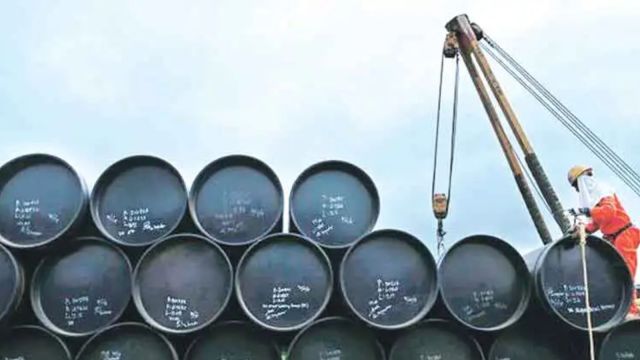There has been no dearth of drama in the escalating trade war between the United States and China, which is having a bearing across sectors globally. Apprehensions of a global recession due to the trade war, which could lead to slump in raw material demand has badly hit commodity markets. Crude oil is not different. Albeit, there are some additional theatrics to be seen in the world’s largest commodity market.
At a time when oil prices were already spiraling amid the intensifying tariff war between Beijing and Washington, the world’s biggest oil exporter Saudi Arabia along with a few allies shockingly added fuel to the fire by announcing a higher-than-anticipated production increase. Riyadh then topped it up with a move to cut the official selling price of its oil for Asian buyers for May.

Consequently, oil prices hit their lowest in over four years with the benchmark Brent crude briefly even slipping below $60 per barrel earlier this week. Another benchmark—West Texas Intermediate, or WTI—which usually trades at a discount to Brent, slid even lower.
While there has been some minor recovery in prices since, the general sentiment around the so-called black gold remains bearish due to growing fears of a possible recession and increasing oil supply by Riyadh-led OPEC and its allies, or OPEC+. For instance, Goldman Sachs slashed its oil price forecast for 2026 twice in less than a week, pegging Brent at $58 per barrel next year. Brent had largely traded between $70 and $90 per barrel for the past two-and-a-half years.
Notably for India, the slump in crude oil prices and the expectation that they will remain subdued for some time comes as a relief, even as various other fallouts of the Trump administration’s tariff policies could lead to some pain for the Indian economy. India is the world’s third-largest consumer of oil with an import dependency level of over 85 per cent. This makes India’s economy vulnerable to global oil price fluctuations. It also has a bearing on the country’s trade deficit, foreign exchange reserves, the rupee’s exchange rate, and inflation rate, among others.
As per latest estimates available with the Petroleum Planning and Analysis Cell of India’s oil ministry, the country’s crude oil import bill for the first 11 months of 2024-25 was almost $220 billion. Oil imports alone accounted for over a third of India’s overall merchandise import bill for the April-February.
Surprise move, dual motive
The move by Saudi Arabia and seven other OPEC+ members to accelerate the unwinding of production cuts came as a surprise. Why would major oil producers increase supply at a time when prices are facing intense downward pressure? Prima facie, the seemingly counterintuitive move by Riyadh appears to have two broad objectives—protect and gain market share even at the cost of a dent in oil revenues, and restore discipline within OPEC+ by reining in producers like Iraq, Kazakhstan, and the United Arab Emirates that were exceeding the agreed production quotas.
Story continues below this ad
Another likely consequence of the move would be the detrimental impact of lower oil prices on American shale oil producers at a time when Donald Trump wants US oil and gas production to be ramped up. As per industry estimates, US shale producers need WTI to average around $65 per barrel to meaningfully expand production without taking on a loss. If oil prices sustain at $60 or below that, as envisaged by some industry analysts, it would be a herculean task for shale producers to ramp up, which indirectly could help dominant players like Saudi Arabia protect their share of the global oil market.
It is worth remembering that a decade ago, Saudi Arabia itself initiated a sharp fall in oil prices by flooding the market, a move directly aimed at denting US shale producers’ ability to increase production at oil price levels that were unviable for them.
“OPEC still sits on substantial spare capacity… Last week’s acceleration in quota unwind from OPEC could be a signal that the group wants to put more of this spare capacity at work, and improve market share… In that case, market rebalancing would require non-OPEC production to slow down more severely, if not decline. As was the case in previous downturns, US shale probably will need to play a role in this,” Morgan Stanley Research said in a recent report.
The caveats
Notwithstanding the current oil prices and the likely trajectory going forward, there are various ifs and buts that could majorly alter the scenario. Chief among them is the shape the trade war takes hereon and its impact on the global economy and consumption. Should it intensify and lead to a recession at a global level, the bearish sentiment on oil is bound to prevail. On the contrary, any positive breakthrough that winds down the tariff wars and allays fears of a recession would certainly offer positive cues for oil prices.
Story continues below this ad
The other big factor is what Saudi Arabia and other OPEC+ members do going forward in terms of managing global oil supply, and how long can they afford an oil price war, as earnings from oil form a substantial chunk of their revenues. A protracted price war and supply glut in the global oil market, while good for consuming countries like India, could deepen the cracks that have emerged within OPEC and OPEC+ over the past few years. It is highly unlikely that Saudi Arabia would want these cartels weakened.

































